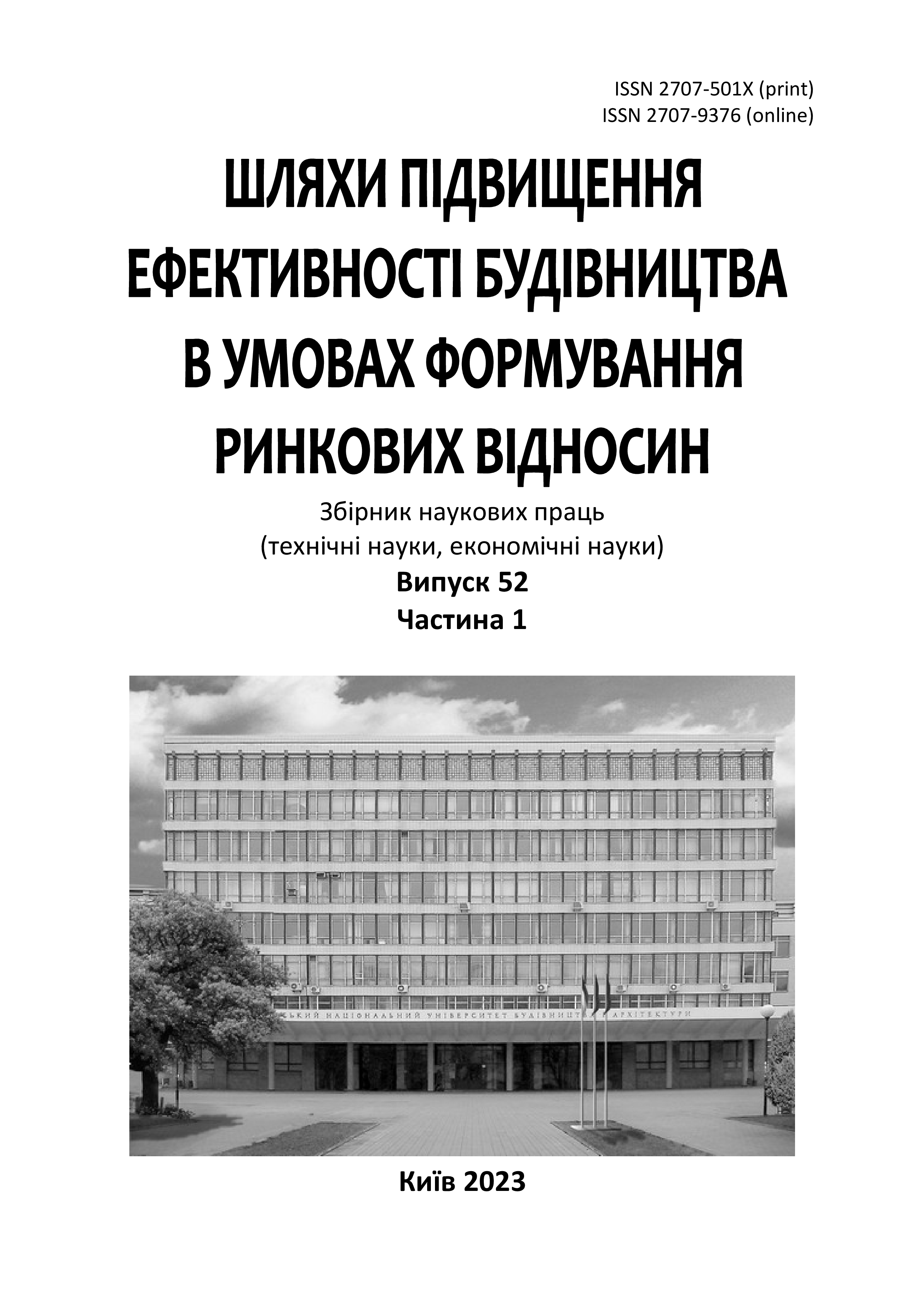Construction life cycle assessment methods and their key features
DOI:
https://doi.org/10.32347/2707-501x.2023.52(1).101-109Keywords:
life cycle assessment, construction object life cycle, construction object life cycle stages, LCA (Life Cycle Analysis), LCC (Life Cycle Costing), LCCA (Life Cycle Cost Analysis), WBLCA (Whole Building Life Cycle Assessment)Abstract
The article examines the methods of assessing the life cycle of construction, as well as defines their key features and role in the strategic management of construction projects. Key features include a comprehensive approach to assessing the impact of construction projects on areas such as the economy, environment and society. The application of life cycle methods in the construction industry is related to: the assessment of the effectiveness of the implementation of construction objects and the need to work out the issue of financial planning and budgeting, taking into account not only the costs of construction, but also the costs of operation and disposal; with the analysis of investment risks, which are extremely important in solving socio-economic issues; implementation of mutually beneficial cooperation schemes between state structures and the private sector; on the attraction of foreign investments in the economy of the state. Analysis of specific construction materials and technologies at different stages of the life cycle can serve as a basis for developing recommendations for choosing materials with a lower environmental impact. The integration of life cycle assessment (LCA) methods with other sustainability and environmental impact assessment methods allows creating more comprehensive approaches to the analysis of objects, services or projects. The results of the research can be used in the development of practical recommendations for builders, designers and other industry participants regarding the use of environmentally friendly materials, technologies and construction methods. The creation of training schools and conditions for the successful implementation of life cycle assessment technologies in the construction industry is extremely important to ensure effective and sustainable development.
References
Construction and energy efficiency. URL: https://en.poyatos.com/blog/construction-and-energy-efficiency/ (дата звернення: 11.09.2023)
Energy Efficiency, Recovery and Storage by Konrad A. Hofman (Editor). Nova Science Pub Inc. 277 p.
Yuksek Izzet, Karadag Ilker. Use of Renewable Energy in Buildings. Chapters, in: Tolga Taner & Archana Tiwari & Taha Selim Ustun (ed.), Renewable Energy – Technologies and Applications, IntechOpen. 2021. https://doi.org/10.5772/intechopen.93571.
Use of Renewable Energy Sources in Architecture. URL: https://omdayal.com/blog/use-of-renewable-energy-sources-in-architecture/ (дата звернення: 11.09.2023).
Цигичко С.П. Екологія в архітектурі і містобудуванні: навч. посібн. Х : ХНАМГ, 2012. 146 с.
Wuxing C., Yingsong L., Shuang C., Chuanfeng Z. Properties and economics evaluation of utilization of oil shale waste as an alternative environmentally-friendly building materials in pavement engineering. Construction and Building Materials, Vol. 259, 2020, 119698. https://doi.org/10.1016/j.conbuildmat.2020.119698.
Madurwar M.V., Ralegaonkar R.V., Mandavgane S.A. Application of agro-waste for sustainable construction materials: A review. Construction and Building Materials, Vol. 38, 2013. P. 872-878. https://doi.org/10.1016/j.conbuildmat.2012.09.011.
Кращі системи "Розумний будинок" по виробниках 2023 року. ТОП 5 надійних та якісних систем "Розумний будинок" рейтингу. URL: https://vencon.ua/ua/articles/reyting-sistem-umnyy-dom-po-proizvoditelyam (дата звернення: 11.09.2023).
Hauschild M.Z. Introduction to LCA Methodology. In: Hauschild, M., Rosenbaum, R., Olsen, S. (eds) Life Cycle Assessment. Springer, Cham. 2018. https://doi.org/10.1007/978-3-319-56475-3_6
ДСТУ ISO 14040:2013. Екологічне управління. Оцінювання життєвого циклу. Принципи та структура (ISO 14040:2006, IDT). URL: https://online.budstandart.com/ua/catalog/doc-page?id_doc=70997 (дата звернення: 18.09.2023)
ДСТУ ISO 14044:2013. Екологічне управління. Оцінювання життєвого циклу. Вимоги та настанови (ISO 14044:2006, IDT). URL: https://online.budstandart.com/ua/catalog/doc-page?id_doc=71016 (дата звернення: 18.09.2023)
Schade J. Life cycle cost calculation models for buildings. URL: https://www.researchgate.net/publication/242404432_LIFE_CYCLE_COST_CALCULATION_MODELS_FOR_BUILDINGS (дата звернення: 18.09.2023)
Білик А.С. Екологічний та економічний аналіз життєвого циклу каркасів будівель: монографія. К.: УЦСБ, КНУБА, 7БЦ, 2022. 263 с.
Flanagan R., Jewell C., Norman G. Whole life appraisal for construction. John Wiley and Sons, 2005.182 р.
Malabi Larsen L.C., Birgisdottir H., Birkved M. Comparing life cycle assessment modelling of linear vs. circular building components. In SBE19 Brussels - BAMB-CIRCPATH "Buildings as Material Banks – A Pathway For A Circular Future" 5–7 February 2019, Brussels, Belgium. IOP Publishing. IOP Conference Series: Earth and Environmental Science. 2019. Vol. 225:012039. https://doi.org/10.1088/1755-1315/225/1/012039.
Downloads
Published
How to Cite
Issue
Section
License

This work is licensed under a Creative Commons Attribution 4.0 International License.
Authors who publish with this journal agree to the following terms:
- Authors retain copyright and grant the journal right of first publication with the work simultaneously licensed under a Creative Commons Attribution License that allows others to share the work with an acknowledgement of the work's authorship and initial publication in this journal.
- Authors are able to enter into separate, additional contractual arrangements for the non-exclusive distribution of the journal's published version of the work (e.g., post it to an institutional repository or publish it in a book), with an acknowledgement of its initial publication in this journal.
- Authors are permitted and encouraged to post their work online (e.g., in institutional repositories or on their website) prior to and during the submission process, as it can lead to productive exchanges, as well as earlier and greater citation of published work (See The Effect of Open Access).

